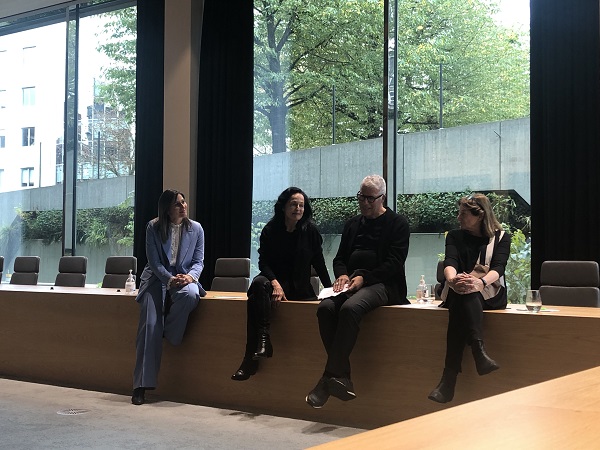 (L-R) Violeta Frank, VF Art Projects; Isabel Muñoz; Paul di Felice; Susan Meiselas;
Credit: Otilia Dragan/Chronicle.lu
(L-R) Violeta Frank, VF Art Projects; Isabel Muñoz; Paul di Felice; Susan Meiselas;
Credit: Otilia Dragan/Chronicle.lu
On Wednesday 18 October 2023, Arendt organised a press lunch at Arendt House in Luxembourg-Kirchberg, to present and celebrate its latest art exhibition, “Hidden Narratives”.
The photographers Susan Meiselas and Isabel Muñoz were present, ahead of the formal vernissage taking place the following day.
Isabel Muñoz is a Spanish photographer based in Madrid, well-known for platinum developments and for body photography as a way of studying and presenting human beings and their stories. Her work has covered themes of climate change and the environment as well as cultural diversity. Susan Meiselas is an American documentary photographer and President of the Magnum Foundation Website, who lives in New York. She is best known for her 1970s photograph documentation of human right issues of war-torn Nicaragua and of American carnival strippers. These two artists with different visual styles nonetheless shared common stories and elements in their photography pertaining to women’s rights and hardships in different parts of the world. As Paul di Felice, the curator, art critic and artist, explained, “photography shows presence and absence”.
In Susan Meiselas’ exhibition, “Room of Their Own”, she showcases the lives of women in a refuge centre in the West Midlands, UK, also known as the “Black Country”. Her photography series referencing Virginia Woolf’s A Room of One’s Own, shows the importance of a space where women can feel safe. Susan Meiselas’ documented these spaces, safe rooms that women who were victims of domestic abuse moved into. “Some women choose to have more things, some choose to have nothing,” she explained. “Sometimes, having nothing means wanting to leave sooner. If you see less, you may think they have nothing but they might have more hope to re-enter society quickly.” Susan Meiselas described her process as “encounters”, whereby she does not go with a clear picture in mind of what she is seeking, but reacting in real time to put herself in the lives of others. She worked in the shelter, in the collective space which led her to be invited into their space. She did this work in collaboration with the women living in the shelter, and she spoke of photography as a “gesture, an offering,” discussing how she offers a copy of the photographs to the women photographed for this series, as a memento and gesture of gratitude. She also discussed how meaningful it was to her that some of the women she worked with during this project kept in touch with her by choice (the shelter did not document and trace its protegees’ names) and sent her photographs of their new family a few years later.
Isabel Muñoz discussed her trip to Cambodia to photograph the Khmer dance – considered a premier art form in Cambodia, whereby performers are taught the techniques from the age of four. Although nearly wiped out by the Khmer Rouge’s “Killing Fields” regime, this centuries-old tradition still had a handful of artists and performers (four from older generations) who managed to keep it alive and worked to pass it along to a new generation. While she was in Cambodia, Isabel Muñoz met a seventeen-year-old dancer whose arm features in one of her striking photographs chosen for this exhibition. This work is particularly symbolic to the photographer as the dancer has since passed away in mysterious circumstances. “Her hand speaks about injustice,” the photographer added. Other excerpts of her work present the struggle of Congolese women in the face of sexual violence as a weapon of war. Isabel Muñoz named Congo “one of the worst countries to be born a woman”. Women deemed to be “mad”, who struggle with mental illness or who are transgender, are very fragile as they are rejected by their tribes and forced to live in inhumane conditions. “They believe in the devil [in Congo]: madness or illness in the head is considered as something that the devil brings, landing such people in the street,” the photographer deplored. But many of these women are “heroines,” fighters who keep going and strive to help each other and find a sense of dignity despite their unimaginable life conditions. Her photography portrays this and presents the individuals in empowering stances: with goods in their headdress to take and sell in the market square, for instance.
Both photographers choose risky, physical situations over working in studio. Their preference to go out into the world and document harsh realities enables them to tell stories that would otherwise not exist, as they both emphasised. They also discussed the importance and limits of photography and the meaning behind having this exhibition in the building of a law firm.
Paul di Felice added: “It’s important to have corporate collections – people here are living with the work, a lot of them linked with the exhibition […] It’s always about societal subjects, not decoration, but really about society and how artists are responding. This is not a collection for speculation.” The presence of such photography in a legal space may spark curiosity, bring real people into the conversation and prompt workers to question their world more, those present noted.
The exhibition “Hidden Narratives” is open to the public and free-of-charge in the Arendt House building until the end of March 2024, every Saturday and Sunday from 09:00 to 18:00.








